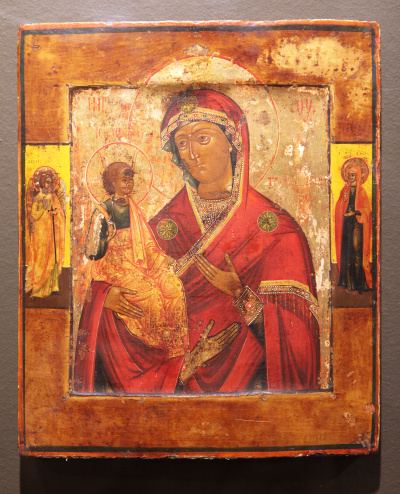The Three-Handed Mother of God
First half of the 17th century, National Gallery Prague
 The inception of this depiction of the Mother of God is connected with events from the life of an important representative of Christian ideology, St. John of Damascus. At the beginning of the iconoclastic movement under the rule of Emperor Leo III the Isaurian, John wrote three extensive tracts against the veneration of icons and sent them to the emperor. The angered emperor couldn´t punish him directly because John was not his subject, he lived in Damascus and was a high court officer of the caliph. That is why the emperor had a letter written in John´s name in which John was proposing him help in the conquest of Syria and sent it, together with his own answer, to the caliph. The latter deprived John of his office and punished him by cutting off his right hand. Some time later John got his hand back, put it to the arm and started praying in front of the icon of the Mother of God. By miracle the wrist grew back to the hand and John could write again. To thank the Virgin he let a hand made of silver and attached it to the icon. The third hand started painting on the icon that was then called the Three-Handed Mother of God.
The inception of this depiction of the Mother of God is connected with events from the life of an important representative of Christian ideology, St. John of Damascus. At the beginning of the iconoclastic movement under the rule of Emperor Leo III the Isaurian, John wrote three extensive tracts against the veneration of icons and sent them to the emperor. The angered emperor couldn´t punish him directly because John was not his subject, he lived in Damascus and was a high court officer of the caliph. That is why the emperor had a letter written in John´s name in which John was proposing him help in the conquest of Syria and sent it, together with his own answer, to the caliph. The latter deprived John of his office and punished him by cutting off his right hand. Some time later John got his hand back, put it to the arm and started praying in front of the icon of the Mother of God. By miracle the wrist grew back to the hand and John could write again. To thank the Virgin he let a hand made of silver and attached it to the icon. The third hand started painting on the icon that was then called the Three-Handed Mother of God.
From iconographic point of view this icon represents the type of the Mother of God hodigitria. The Christ is sitting on the arm of his mother, blessing with his right hand and holding a scroll or a book in his left hand. The icon expresses symbolically the arrival of the „heavenly ruler and judge“ on Earth and his veneration.